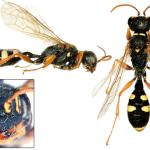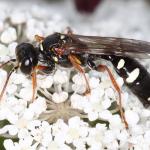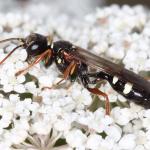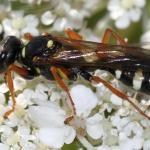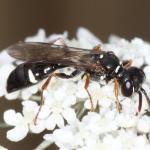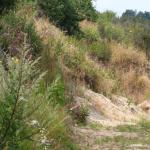Crabro sabulosus Fabricius, 1787; Sphex ruficornis Villers, 1789; Crabro frontalis Panzer, 1797; Crabro petiolatus Panzer, 1797; Mellinus fulvicornis Fabricius, 1804; Anthophilus hellmanni Radoszkowski, 1888
Historically the less common of our two Mellinus species and possibly now extinct in Britain. In M. crabroneus, the abdominal markings are ivory coloured and not yellow (as in M. arvensis)
Records are scattered widely across England north to Northumberland; also in south Wales and Anglesey. There is an old, unconfirmed record for "Dumfriesshire" (Service, 1879). The east coast is particularly well represented within the data, but records are inexplicably sparse or absent from many heathland districts of southern England. Overseas, found in Europe and eastwards through the steppes as far east as Manchuria and Korea.
Listed as an Endangered species (RDB1), but presumed to be extinct (Shirt, 1987; Falk, 1991). A decline seemed to occur after the 1920s and the last record was for Spurn Head in 1952. It has been searched for at several known localities since, without success. A number of old records mention its abundance at individual sites.
Recorded from a variety of open sandy habitats including heathland (but only in certain areas), soft rock cliffs and coastal landslips, and possibly coastal dunes.
Univoltine; June to September.
Flies such as syrphids, muscids and anthomyiids (Lomholdt, 1975-76).
Nests in burrows in sandy ground, such as along footpaths, often in aggregations. Lomholdt (1975-76) states that nests consist of a main tunnel 5-30 cm long, with 3-6 side tunnels, each terminating in a cell. Twelve to fifteen flies are stored in each nest (Hamm & Richards, 1930).
Umbellifers such as wild carrot (Daucus carota), hogweed (Heracleum sphondylium) and wild angelica (Angelica sylvestris), which are also likely to act as a source of prey. Males have also been observed swarming around low foliage in the same manner as the common Mellinus arvensis.
None recorded but likely to include various sarcophagid flies such as Metopia species.
1998
Proofed: March 2012


